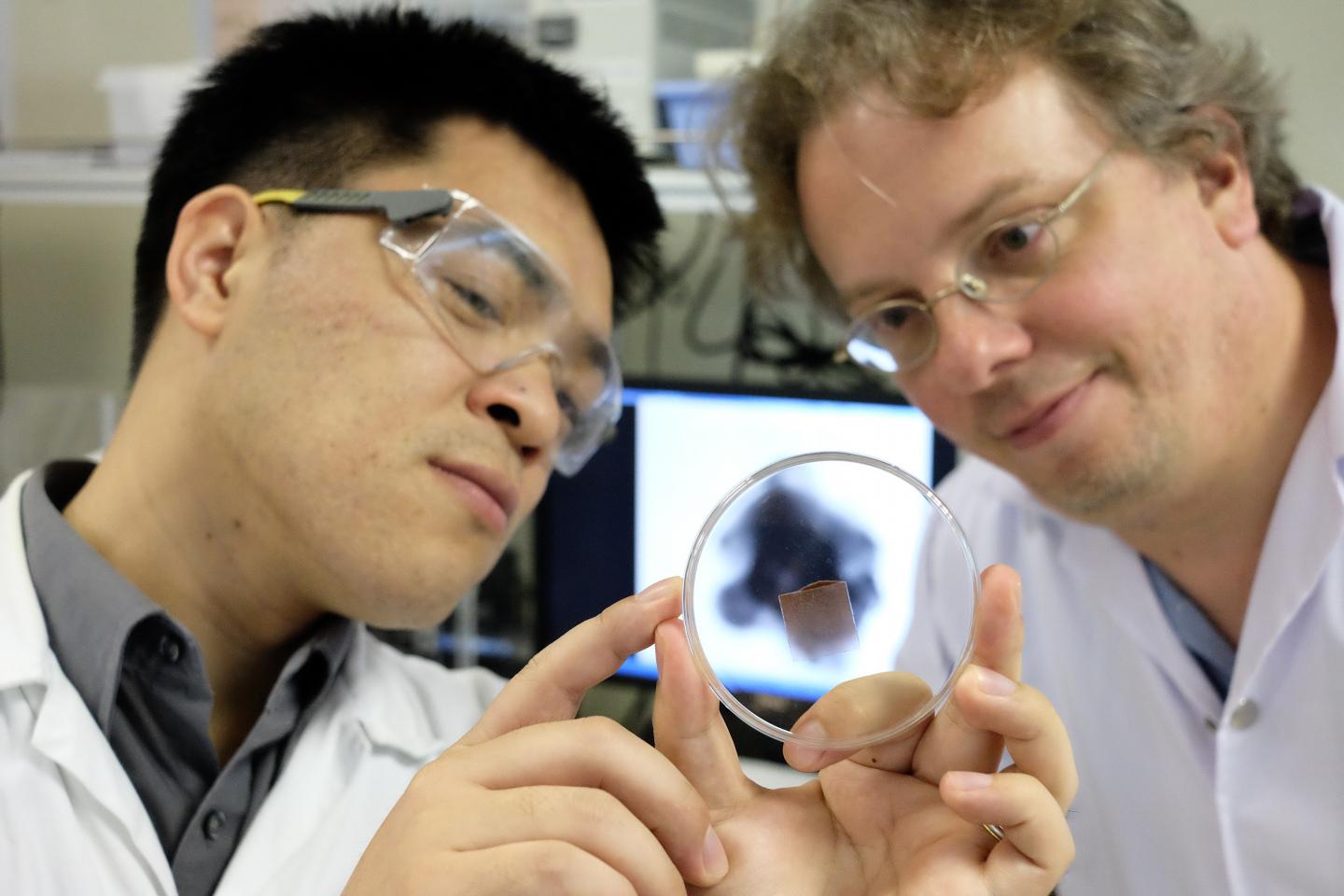Scientists at Nanyang Technological University (NTU Singapore) have invented a new way to deliver cancer drugs deep into tumor cells.
The NTU scientists create micro-sized gas bubbles coated with cancer drug particles and iron oxide nanoparticles, and then use magnets to direct these bubbles to gather around a specific tumor.
Ultrasound is then used to vibrate the microbubbles, providing the energy to direct the drug particles into a targeted area.
This innovative technique was developed by a multidisciplinary team of scientists, led by Asst Prof Xu Chenjie from the School of Chemical and Biomedical Engineering and Assoc Prof Claus-Dieter Ohl from the School of Physical and Mathematical Sciences.
NTU’s microbubbles were successfully tested in mice and the study has been published by the Nature Publishing Group in Asia Materials, the top journal for materials sciences in the Asia-Pacific region.

Asst. Prof. Xu Chenjie (left) and Assoc. Prof. Claus-Dieter Ohl (right) are looking at the magnetic bubbles on a petridish. (Credit: NTU Singapore)
Overcoming Limitations of Chemotherapy
Asst Prof Xu, who is also a researcher at the NTU-Northwestern Institute for Nanomedicine, said their new method may solve some of the most pressing problems faced in chemotherapy used to treat cancer.
The main issue is that current chemotherapy drugs are largely non-targeted. The drug particles flow in the bloodstream, damaging both healthy and cancerous cells. Typically, these drugs are flushed away quickly in organs such as the lungs and liver, limiting their effectiveness.
The remaining drugs are also unable to penetrate deep into the core of the tumor, leaving some cancer cells alive, which could lead to a resurgence in tumor growth.
“The first unique characteristic of our microbubbles is that they are magnetic. After injecting them into the bloodstream, we are able to gather them around the tumor using magnets and ensure that they don’t kill the healthy cells,” explains Asst Prof Xu, who has been working on cancer diagnosis and drug delivery systems since 2004.
“More importantly, our invention is the first of its kind that allows drug particles to be directed deep into a tumor in a few milliseconds. They can penetrate a depth of 50 cell layers or more – which is about 200 micrometers, twice the width of a human hair. This helps to ensure that the drugs can reach the cancer cells on the surface and also inside the core of the tumor.”
Clinical Associate Professor Chia Sing Joo, a Senior Consultant at the Tan Tock Seng Hospital’s Endoscopy Centre and the Urology & Continence Clinic, was one of the consultants for this study.
A trained robotic surgeon experienced in the treatment of prostate, bladder and kidney cancer, Assoc Prof Chia said, “For anticancer drugs to achieve their best effectiveness, they need to penetrate into the tumor efficiently in order to reach the cystoplasm of all the cancer cells that are being targeted without affecting the normal cells.
“Currently, these can be achieved by means of a direct injection into the tumor or by administering a large dosage of anticancer drugs, which can be painful, expensive, impractical and might have various side effects.”
The specialist in Uro-oncology added that if NTU’s technology proves to be viable, clinicians might be able to localize and concentrate the anticancer drugs around a tumor, and introduce the drugs deep into tumor tissues in just a few seconds using a clinical ultrasound system.
“If successful, I envisage it can be a good alternative treatment in the future, one which is low cost and yet effective for the treatment of cancers involving solid tumors, as it might minimize the side effects of drugs.”
New Drug Delivery System
The motivation for this research project is to find alternative solutions for drug delivery systems that are non-invasive and safe.
Ultrasound uses soundwaves with frequencies higher than those heard by the human ear. It is commonly used for medical imaging such as to get diagnostic images.
Magnets, which can draw and attract the microbubbles, are already in use in diagnostic machines such the Magnetic Resonance Imaging (MRI).
“We are looking at developing novel drug carriers – essentially better ways of delivering drugs with minimum side effects,” explained Prof Ohl, an expert in biophysics who had published previous studies involving drug delivery systems and bubble dynamics.
“Most prototype drug delivery systems on the market face three main challenges before they can be commercially successful: they have to be non-invasive, patient-friendly and yet cost-effective.
“Using the theory of microbubbles and how their surface vibrates under ultrasound, we were able to come up with our solution that addresses these three challenges.”
Interdisciplinary Team
This study, which took two and a half years, involved a 12-man international interdisciplinary team consisting of NTU scientists as well as scientists from City University of Hong Kong and Tel Aviv University in Israel. Two NTU undergraduates doing their Final Year Project and one student in Summer Research Internship Programme (NTU) were also part of the team.
Moving forward, the team will be adopting this new drug delivery system in studies on lung and liver cancer using animal models, and eventually clinical studies.
They estimate that it will take another eight to ten years before it reaches human clinical trials.
Find more information on the study here.
